D-Link DIR-857 User Manual

User Manual
Wireless N Quadband HD Media Router

Preface
D-Link reserves the right to revise this publication and to make changes in the content hereof without obligation to notify any person or organization of such revisions or changes.
Manual Revisions
Revision |
Date |
Description |
1.0 |
October 25, 2011 |
• Initial release |
|
|
|
Trademarks
D-Link and the D-Link logo are trademarks or registered trademarks of D-Link Corporation or its subsidiaries in the United States or other countries. All other company or product names mentioned herein are trademarks or registered trademarks of their respective companies.
Copyright © 2011 by D-Link Systems, Inc.
All rights reserved. This publication may not be reproduced, in whole or in part, without prior expressed written permission from D-Link Systems, Inc.
D-Link DIR-857 User Manual |
i |

Table of Contents
Table of Contents
Preface.................................................................................................. |
i |
Manual Revisions............................................................................................... |
i |
Trademarks........................................................................................................... |
i |
Product Overview.............................................................................. |
1 |
Package Contents............................................................................................ |
1 |
System Requirements.................................................................................... |
2 |
Introduction....................................................................................................... |
3 |
Features...................................................................................................... |
4 |
Hardware Overview........................................................................................ |
6 |
Connections.............................................................................................. |
6 |
Hardware Overview........................................................................................ |
7 |
Front View.................................................................................................. |
7 |
LEDs............................................................................................................. |
8 |
Installation.......................................................................................... |
9 |
Before you Begin.............................................................................................. |
9 |
Wireless Installation Considerations....................................................... |
10 |
Getting Started............................................................................................... |
11 |
Configuration................................................................................... |
12 |
Quick Setup Wizard....................................................................................... |
12 |
Web-based Configuration Utility............................................................. |
15 |
Setup Wizard.......................................................................................... |
16 |
Internet Connection....................................................................... |
16 |
Wireless Settings............................................................................. |
16 |
Manual Configuration......................................................................... |
20 |
Dynamic (Cable).............................................................................. |
20 |
Internet Setup........................................................................................ |
21 |
PPPoE (DSL)....................................................................................... |
21 |
PPTP..................................................................................................... |
22 |
L2TP..................................................................................................... |
23 |
Static (assigned by ISP)................................................................. |
24 |
DS-Lite................................................................................................. |
25 |
Wireless Settings................................................................................... |
26 |
802.11n/g (2.4GHz)......................................................................... |
27 |
802.11n/g (5GHz)............................................................................ |
28 |
Network Settings.................................................................................. |
29 |
DHCP Server Settings.................................................................... |
30 |
DHCP Reservation........................................................................... |
31 |
Media Server........................................................................................... |
32 |
IPv6 Internet Connection................................................................... |
33 |
IPv6 Internet Connection Setup Wizard....................................... |
34 |
IPv6 Manual Setup............................................................................... |
39 |
Auto Detection................................................................................ |
39 |
Static IPv6.......................................................................................... |
40 |
Autoconfiguration.......................................................................... |
41 |
PPPoE................................................................................................... |
42 |
IPv6 in IPv4 Tunneling................................................................... |
44 |
6 to 4 Tunneling............................................................................... |
45 |
6rd........................................................................................................ |
46 |
Link-Local Connectivity................................................................ |
47 |
Parental Controls................................................................................... |
48 |
D-Link DIR-857 User Manual |
ii |

Table of Contents
Virtual Server.......................................................................................... |
49 |
DDNS......................................................................................................... |
77 |
|
Port Forwarding.................................................................................... |
51 |
System Check......................................................................................... |
78 |
|
Application Rules.................................................................................. |
52 |
Schedules................................................................................................ |
79 |
|
QoS Engine.............................................................................................. |
53 |
Device Information.............................................................................. |
80 |
|
Network Filters....................................................................................... |
55 |
Log............................................................................................................. |
81 |
|
Access Control....................................................................................... |
56 |
Stats........................................................................................................... |
82 |
|
Access Control Wizard................................................................... |
56 |
Active Sessions...................................................................................... |
82 |
|
Website Filters........................................................................................ |
59 |
Wireless.................................................................................................... |
83 |
|
Inbound Filters....................................................................................... |
60 |
IPv6............................................................................................................ |
84 |
|
Firewall Settings.................................................................................... |
61 |
Support.................................................................................................... |
85 |
|
Application Level Gateway Configuration................................... |
62 |
Wireless Security |
86 |
|
Routing |
63 |
|||
What is WPA? |
86 |
|||
Advanced Wireless Settings |
64 |
|||
Wi-PnP Wireless Setup |
87 |
|||
WISH Settings |
65 |
|||
Wireless Security Setup Wizard |
89 |
|||
Wi-Fi Protected Setup (WPS) |
66 |
|||
Configure WPA-Personal (PSK) |
91 |
|||
Advanced Network Settings |
67 |
|||
Configure WPA-Enterprise (RADIUS) |
92 |
|||
UPnP |
67 |
|||
Using Windows® 7 and WPS for Wireless Configuration |
94 |
|||
Internet Ping Block |
67 |
|||
DIR-857 |
95 |
|||
Internet Port Speed |
67 |
|||
|
|
|||
Multicast Streams............................................................................ |
67 |
Connect to a Wireless Network....................................................... |
97 |
|
Guest Zone.............................................................................................. |
68 |
Using Windows® 7.......................................................................................... |
97 |
|
IPv6 Firewall............................................................................................ |
69 |
Using Windows Vista®................................................................................ |
100 |
|
IPv6 Routing........................................................................................... |
70 |
Configure Wireless Security........................................................... |
101 |
|
Administrator Settings........................................................................ |
71 |
Using Windows® XP.................................................................................... |
103 |
|
Time Settings......................................................................................... |
72 |
Configure WPA-PSK........................................................................... |
104 |
|
SysLog....................................................................................................... |
73 |
Troubleshooting |
106 |
|
Email Settings |
74 |
|||
|
|
|||
System Settings..................................................................................... |
75 |
Wireless Basics |
110 |
|
Update Firmware |
76 |
|||
|
|
|||
|
|
|
|
|
D-Link DIR-857 User Manual |
|
|
iii |

Table of Contents |
|
Tips................................................................................................................... |
112 |
Wireless Modes............................................................................................ |
113 |
Networking Basics.......................................................................... |
114 |
Check your IP address............................................................................... |
114 |
Technical Specifications................................................................. |
116 |
D-Link DIR-857 User Manual |
iv |

Section 1 - Product Overview
ProductPackageOverviewContents
DIR-857 Wireless N Quadband HD Media Router
Ethernet Cable
Power Adapter
CD-ROM with Manual and Setup Wizard
If any of the above items are missing, please contact your reseller.
Note: Using a power supply with a different voltage rating than the one included with the DIR-857 will cause damage and void the warranty.
D-Link DIR-857 User Manual |
1 |

Section 1 - Product Overview
System Requirements
|
• An Ethernet-based Cable or DSL modem |
|
Network Requirements |
• IEEE 802.11n or 802.11g wireless clients |
|
• IEEE 802.11a wireless clients |
||
|
||
|
• 10/100/1000 Ethernet |
|
|
|
|
|
Computer with the following: |
|
|
•Windows®, Macintosh, or Linux-based operating system |
|
|
• An installed Ethernet adapter |
|
Web-based Configuration |
Browser Requirements: |
|
• Internet Explorer 6.0 or higher |
||
Utility Requirements |
• Chrome 2.0 or higher |
|
|
• Firefox 3.0 or higher |
|
|
• Safari 3.0 or higher (with Java 1.3.1 or higher) |
|
|
Windows® Users: Make sure you have the latest version of Java |
|
|
installed. Visit www.java.com to download the latest version. |
|
|
|
|
CD Installation Wizard |
Computer with the following: |
|
•Windows® 7,Vista®, or XP with Service Pack 2 |
||
Requirements |
• An installed Ethernet adapter |
|
|
• CD-ROM drive |
|
|
|
D-Link DIR-857 User Manual |
2 |

Section 1 - Product Overview
Introduction
TOTAL PERFORMANCE
Combines award winning router features and 802.11a/n/g wireless technology to provide the best wireless performance.
TOTAL SECURITY
The most complete set of security features including Active Firewall and WPA2™ to protect your network against outside intruders.
TOTAL COVERAGE
Provides greater wireless signal rates even at farther distances for best-in-class Whole Home Coverage.
ULTIMATE PERFORMANCE
The D-Link Wireless N Quadband HD Media Router (DIR-857) is a 802.11n/802.11a compliant device that delivers real world performance of up to 13x faster than an 802.11g wireless connection (also faster than a 100Mbps wired Ethernet connection). Create a secure wireless network to share photos, files, music, video, printers, and network storage throughout your home. Connect the Wireless N Quadband HD Media Router to a cable or DSL modem and share your high-speed Internet access with everyone on the network. In addition, this Router includes a Quality of Service (QoS) engine that keeps digital phone calls (VoIP) and online gaming smooth and responsive, providing a better Internet experience.
EXTENDED WHOLE HOME COVERAGE
This high performance router provides superior Whole Home Coverage while reducing dead spots. The Wireless N Quadband HD Media Router is designed for use in bigger homes and for users who demand higher performance networking. Add a notebook or desktop adapter and stay connected to your network from virtually anywhere in your home.
TOTAL NETWORK SECURITY
The Wireless N Quadband HD Media Router supports all of the latest wireless security features to prevent unauthorized access, be it from over the wireless network or from the Internet. Support for WPA standards ensure that you’ll be able to use the best possible encryption method, regardless of your client devices. In addition, this Wireless N Quadband HD Media Router utilizes dual active firewalls (SPI and NAT) to prevent potential attacks from across the Internet.
* Maximum wireless signal rate derived from IEEE Standard 802.11a, 802.11g, and 802.11n specifications. Actual data throughput will vary. Network conditions and environmental factors, including volume of network traffic, building materials and construction, and network overhead, lower actual data throughput rate. Environmental conditions will adversely affect wireless signal range.
D-Link DIR-857 User Manual |
3 |

Section 1 - Product Overview
Features
•FasterWirelessNetworking- The DIR-857 provides up to 900Mbps* wireless connection with other 802.11n wireless clients. This capability allows users to participate in real-time activities online, such as video streaming, online gaming, and real-time audio. The performance of this 802.11n wireless router gives you the freedom of wireless networking at speeds 13x faster than 802.11g.
•Compatible with 802.11a/g Devices - The DIR-857 is still fully compatible with the IEEE 802.11g and 802.11a standards, so it can connect with existing 802.11g and 802.11a PCI, USB, and Cardbus adapters.
•Advanced Firewall Features - The Web-based user interface displays a number of advanced network management features including:
•Content Filtering - Easily applied content filtering based on MAC Address, URL, and/or Domain Name.
•Filter Scheduling - These filters can be scheduled to be active on certain days or for a duration of hours or minutes.
•Secure Multiple/Concurrent Sessions - The DIR-857 can pass through VPN sessions. It supports multiple and concurrent IPSec and PPTP sessions, so users behind the DIR-857 can securely access corporate networks.
•User-friendly SetupWizard - Through its easy-to-use Web-based user interface, the DIR-857 lets you control what information is accessible to those on the wireless network, whether from the Internet or from your company’s server. Configure your router to your specific settings within minutes.
*Maximum wireless signal rate derived from IEEE Standard 802.11a, 802.11g, and 802.11n specifications. Actual data throughput will vary. Network conditions and environmental factors, including volume of network traffic, building materials and construction, and network overhead, lower actual data throughput rate. Environmental conditions will adversely affect wireless signal range.
D-Link DIR-857 User Manual |
4 |

Section 1 - Product Overview
•Fast and GuaranteeWireless Streaming forVideo Quality - Whether set-top box or gaming console streaming media directly from the Internet, a NAS or PC, these devices share in common the need to connect with a router in order to communicate and establish the wireless media stream. The DIR-857 offers stability, fast wireless, and guaranteed performance for media streaming using the newest streaming engine technology.
•StorageforPhotosandStreamingMusic/Video-A compact SD Card can be placed inside this router to act as network storage. Without any cumbersome cables or protruding antennas, you can wirelessly share this disk space among family members, stream stored music and video to media players attached to stereo systems or TV, and provide remote access to your personal documents from the Internet.
•Share Multifunction Printers and Direct Connection to USB Storage - Through the SharePort™ Plus Utility, you can connect multifunction printers to the USB ports to share printing and scanning functions among family members.
•Other Features Include -
•Wi-Fi Protected Setup (WPS) Push Button
•UPnP Support
•SD Card Slot to share music/video/images
•HD Fuel™ for smooth video streaming and online gaming
•D-Link Green™
•Wi-PnP for easy wireless setup (required USB thumb drive)
•Supports IPv6
•True Gigabit Routing Connectivity
D-Link DIR-857 User Manual |
5 |

Section 1 - Product Overview
Hardware Overview
Connections
1 |
2 |
3 |
4 |
5 |
6 |
1 |
LAN Ports (1-4) |
Connect Ethernet devices such as computers, switches, and hubs. |
|
|
|
|
|
2 |
Internet Port |
The auto MDI/MDIX Internet port is the connection for the Ethernet cable to the cable |
|
or DSL modem. |
|||
|
|
||
|
|
|
|
3 |
USB |
Connect a USB 1.1, 2.0, or 3.0 flash drive to configure the wireless settings using WCN. |
|
|
|
|
|
4 |
Reset |
Press and hold the reset button to restore the router to its original factory settings. |
|
|
|
|
|
5 |
Power Button |
Press the power button to power on and off. |
|
|
|
|
|
6 |
Power Receptor |
Receptor for the supplied power adapter. |
|
|
|
|
D-Link DIR-857 User Manual |
6 |

Section 1 - Product Overview
Hardware Overview
Front View
|
|
|
|
|
|
|
|
|
|
|
|
|
|
|
|
1 |
2 |
|||
|
|
|
|
|
||
1 |
WPS Button |
Press this button to add your device to an existing network or to create a new network. |
||||
Power LED will blink on and off when WPS button is pressed |
||||||
|
|
|||||
|
|
Insert your SD Card for sharing multimedia files such as video, music, and images. You |
||||
|
|
may access the files on the SD card by opening a web browser and enter \\dlinkrouter. |
||||
2 |
SD Card Port |
The power LED will be blinking blue when the SD card is in use. Note that removing the |
||||
SD card while the power LED is blinking will damage your SD card. |
||||||
|
|
|||||
Currently FAT and FAT32 file formats support full read/write access to the SD card. Other formats may only support read-only.
D-Link DIR-857 User Manual |
7 |

Section 1 - Product Overview
LEDs
2
1
1 |
Power LED |
A solid light indicates a proper connection to the power supply. |
A solid light indicates connection on the Internet port. This LED blinks during data 2 Internet LED transmission. A solid blue light indicates that there is an Internet connection, an orange
light indicates that there is none.
D-Link DIR-857 User Manual |
8 |

Section 2 - Installation
Installation
This section will walk you through the installation process. Placement of the router is very important. Do not place the router in an enclosed area such as a closet, cabinet, or in the attic or garage.
Before you Begin
Please configure the router with the computer that was last connected directly to your modem. Also, you can only use the Ethernet port on your modem. If you were using the USB connection before using the router, then you must turn off your modem, disconnect the USB cable and connect an Ethernet cable to the Internet port on the router, and then turn the modem back on. In some cases, you may need to call your ISP to change connection types (USB to Ethernet).
If you have DSL and are connecting via PPPoE, make sure you disable or uninstall any PPPoE software such as WinPoet, Broadjump, or Enternet 300 from your computer or you will not be able to connect to the Internet.
D-Link DIR-857 User Manual |
9 |

Section 2 - Installation
Wireless Installation Considerations
The D-Link wireless router lets you access your network using a wireless connection from virtually anywhere within the operating range of your wireless network. Keep in mind that the number, thickness and location of walls, ceilings, or other objects that the wireless signals must pass through, may limit the range. Typical ranges vary depending on the types of materials and background RF (radio frequency) noise in your home or business. The key to maximizing wireless range is to follow these basic guidelines:
1.Keep the number of walls and ceilings between the D-Link router and other network devices to a minimum - each wall or ceiling can reduce your adapter’s range from 3-90 feet (1-30 meters.) Position your devices so that the number of walls or ceilings is minimized.
2.Be aware of the direct line between network devices. A wall that is 1.5 feet thick (.5 meters), at a 45-degree angle appears to be almost 3 feet (1 meter) thick. At a 2-degree angle it looks over 42 feet (14 meters) thick! Position devices so that the signal will travel straight through a wall or ceiling (instead of at an angle) for better reception.
3.Building Materials make a difference. A solid metal door or aluminum studs may have a negative effect on range. Try to position access points, wireless routers, and computers so that the signal passes through drywall or open doorways. Materials and objects such as glass, steel, metal, walls with insulation, water (fish tanks), mirrors, file cabinets, brick, and concrete will degrade your wireless signal.
4.Keep your product away (at least 3-6 feet or 1-2 meters) from electrical devices or appliances that generate RF noise.
5.If you are using 2.4GHz cordless phones or X-10 (wireless products such as ceiling fans, lights, and home security systems), your wireless connection may degrade dramatically or drop completely. Make sure your 2.4GHz phone base is as far away from your wireless devices as possible. The base transmits a signal even if the phone in not in use.
D-Link DIR-857 User Manual |
10 |
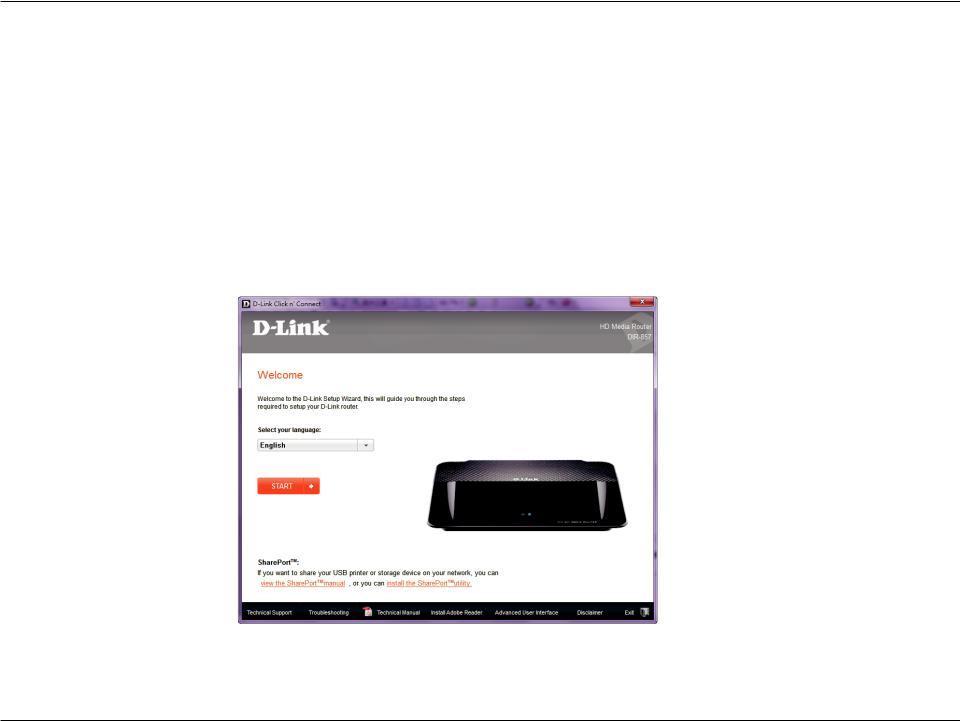
Section 2 - Installation
Getting Started
The DIR-857 includes a Quick Router Setup Wizard CD. Follow the simple steps below to run the Setup Wizard to guide you quickly through the installation process.
Insert the Wizard CD in the CD-ROM drive. The step-by-step instructions that follow are shown in Windows® XP. The steps and screens are similar for the other Windows operating systems.
If the CD Autorun function does not automatically start on your computer, go to Start > Run. In the run box type “D:\autorun.exe” (where D: represents the drive letter of your CD-ROM drive).
When the autorun screen appears, click START.
Note: It is recommended to write down the SSID and Security Key, followed by the login password on the provided CD holder.
D-Link DIR-857 User Manual |
11 |
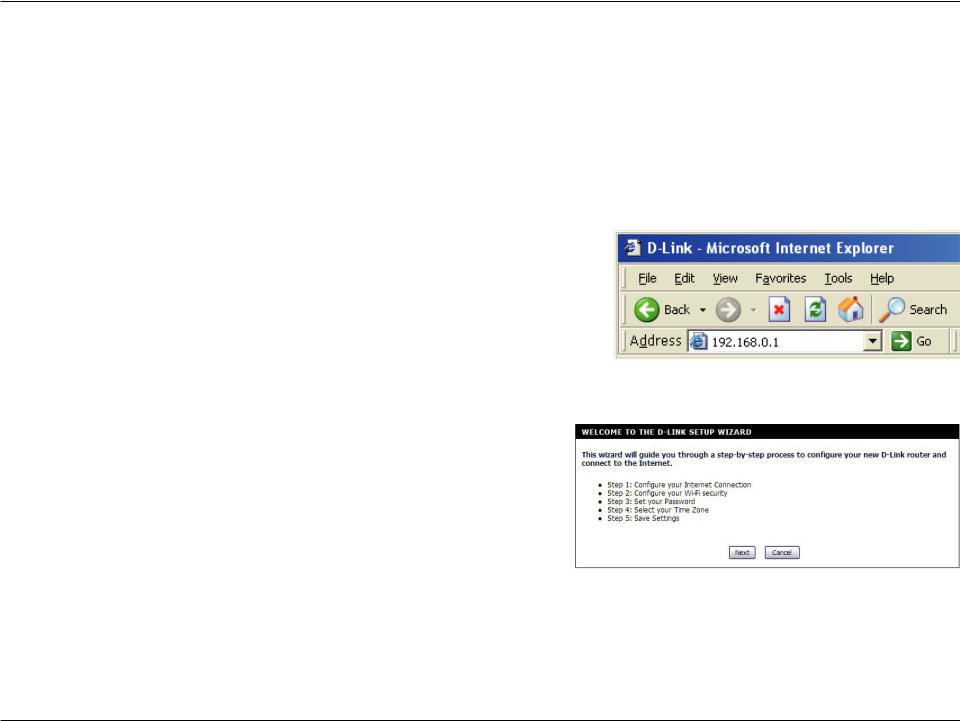
Section 3 - Configuration
Configuration
This section will show you how to configure your new D-Link wireless router using the web-based configuration utility.
Quick Setup Wizard
To access the configuration utility, open a web-browser such as Internet
Explorer and enter the IP address of the router (192.168.0.1).
You may also connect using the NetBIOS name in the address bar (http://dlinkrouter).
This wizard is designed to guide you through a step-by step process to configure your new D-Link router and connect to the Internet.
Click Next to continue.
D-Link DIR-857 User Manual |
12 |

Section 3 - Configuration
Please wait while your router detects your internet connection type.
Please give your network a name using up to 32 characters.
Click Next to continue.
In order to secure your new networking device, please enter a password and click Next.
D-Link DIR-857 User Manual |
13 |

Section 3 - Configuration
Select your time zone from the drop-down menu and click Next to continue.
Once this screen appears, your setup is complete. Click Save & Connect to reboot the router.
Before your router reboots, you will be asked if you want to bookmark ‘D-Link Router Web Management,” click Ok to finish.
D-Link DIR-857 User Manual |
14 |
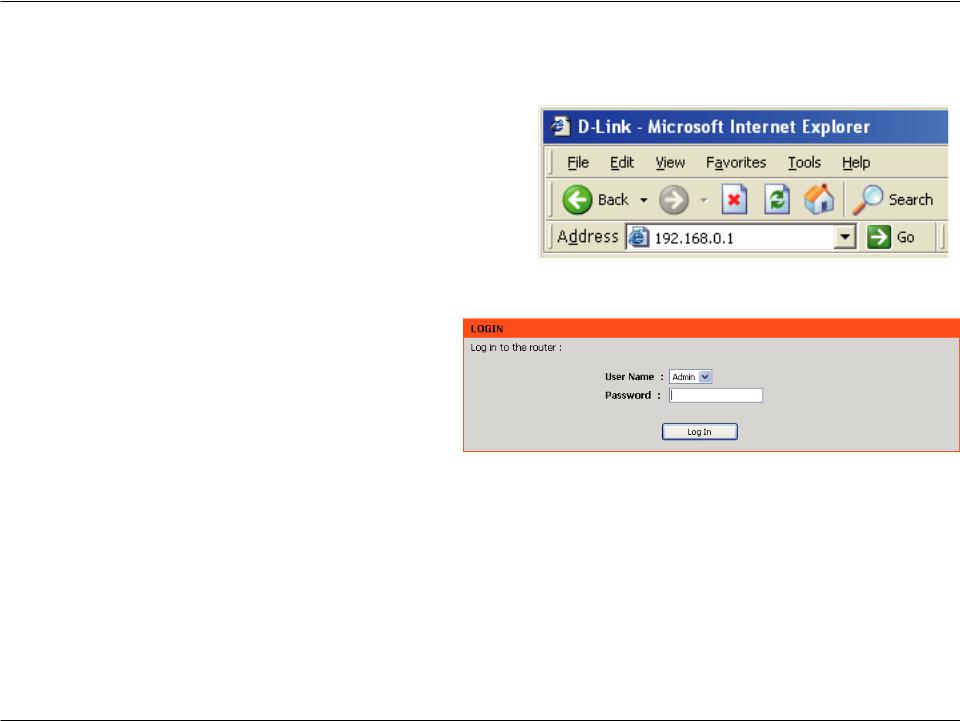
Section 3 - Configuration
Web-based Configuration Utility
To access the configuration utility, open a web-browser such as
Internet Explorer and enter the IP address of the router (192.168.0.1).
You may also connect using the NetBIOS name in the address bar (http://dlinkrouter).
Select Admin from the drop-down menu and then enter your password. Leave the password blank by default.
If you get a Page Cannot be Displayed error, please refer to the
Troubleshooting section for assistance.
D-Link DIR-857 User Manual |
15 |
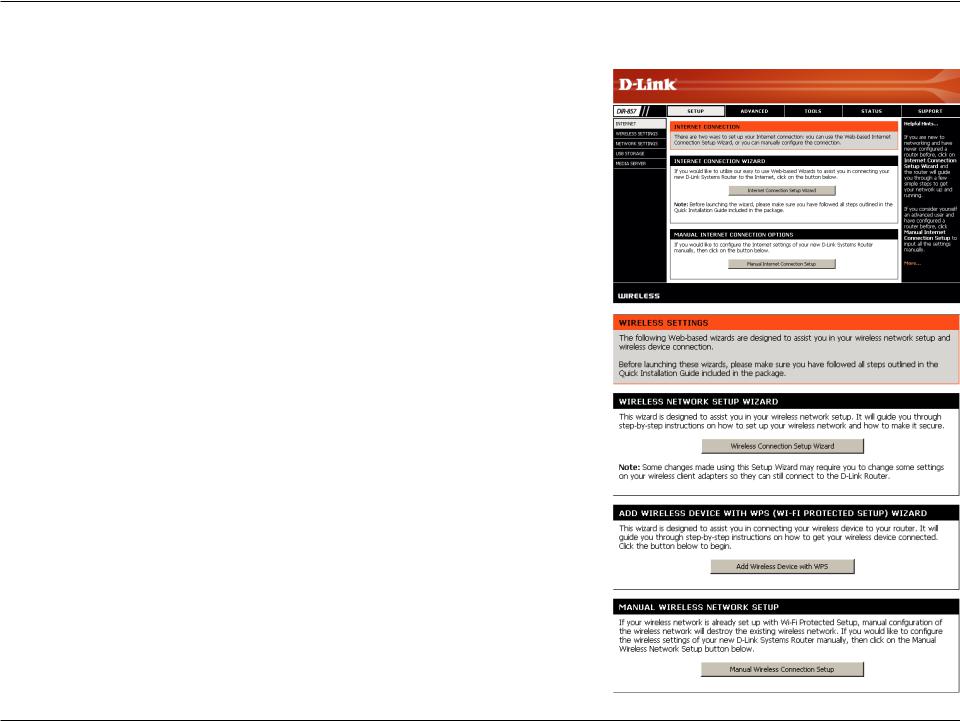
Section 3 - Configuration
Setup Wizard
Internet Connection
Click Internet Connection Setup Wizard to quickly configure your router. Skip to the next page.
If you want to enter your settings without running the wizard, click Manual Configuration and skip to page 15.
Wireless Settings
Click Wireless Connection Setup Wizard to begin. Skip to page 81.
If you want to add your wireless clients to your router using WPS, click Add Wireless
Device with WPS and skip to page 74.
If you want to configure your wireless settings manually, click Manual Wireless Connection Setup and skip to page 21.
D-Link DIR-857 User Manual |
16 |

Section 3 - Configuration
Click Next to continue.
Create a new password and then click Next to continue.
Select your time zone from the drop-down menu and then click Next to continue.
Select the type of Internet connection you use and then click Next to continue.
D-Link DIR-857 User Manual |
17 |

Section 3 - Configuration
If you selected Dynamic, you may need to enter the MAC address of the computer that was last connected directly to your modem. If you are currently using that computer, click Clone Your PC’s MAC Address and then click Next to continue.
The Host Name is optional but may be required by some ISPs. The default host name is the device name of the Router and may be changed.
If you selected PPPoE, enter your PPPoE username and password. Click Next to continue.
Select Static if your ISP assigned you the IP address, subnet mask, gateway, and DNS server addresses.
Note: Make sure to remove your PPPoE software from your computer. The software is no longer needed and will not work through a router.
If you selected PPTP, enter your PPTP username and password. Click Next to continue.
D-Link DIR-857 User Manual |
18 |

Section 3 - Configuration
If you selected L2TP, enter your L2TP username and password. Click Next to continue.
If you selected Static, enter your network settings supplied by your Internet provider. Click Next to continue.
Click Connect to save your settings. Once the router is finished rebooting, click Continue. Please allow 1-2 minutes to connect.
Close your browser window and reopen it to test your Internet connection. It may take a few tries to initially connect to the Internet.
D-Link DIR-857 User Manual |
19 |

Section 3 - Configuration
Manual Configuration
Dynamic (Cable)
My Internet Select Dynamic IP (DHCP) to obtain IP Address information automatically from your Connection: ISP. Select this option if your ISP does not give you any IP numbers to use. This option is
commonly used for cable modem services such as Comcast and Cox.
Host Name: The Host Name is optional but may be required by some ISPs. Leave blank if you are not sure.
Use Unicasting: Check the box if you are having problems obtaining an IP address from your ISP.
DNS Servers: Enter the Primary and secondary DNS server IP addresses assigned by your ISP. These addresses are usually obtained automatically from your ISP. Leave at 0.0.0.0 if you did not specifically receive these from your ISP.
MTU: Maximum Transmission Unit - you may need to change the MTU for optimal performance with your specific ISP. 1500 is the default MTU.
MAC Address: The default MAC Address is set to the Internet port’s physical interface MAC address on the Broadband Router. It is not recommended that you change the default MAC address unless required by your ISP. You can use the Clone Your PC’s MAC Address button to replace the Internet port’s MAC address with the MAC address of your Ethernet card.
D-Link DIR-857 User Manual |
20 |
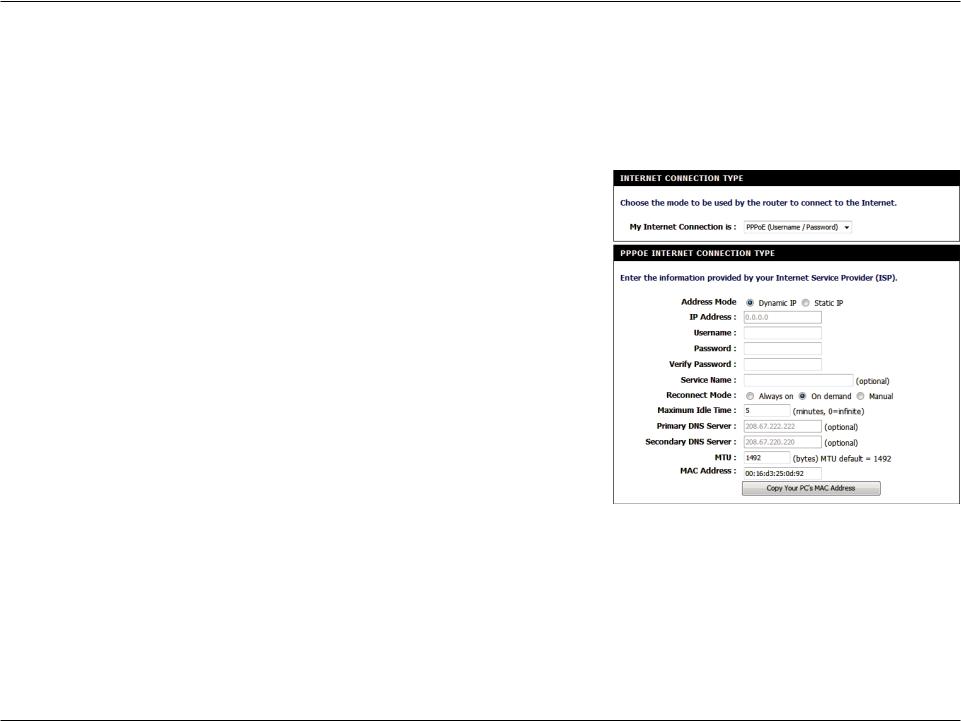
Section 3 - Configuration
Internet Setup
PPPoE (DSL)
Choose PPPoE (Point to Point Protocol over Ethernet) if your ISP uses a PPPoE connection. Your ISP will provide you with a username and password. This option is typically used for DSL services. Make sure to remove your PPPoE software from your computer. The software is no longer needed and will not work through a router.
My Internet Select PPPoE (Username/Password) from the drop-down menu.
Connection:
Address Mode: Select Static if your ISP assigned you the IP address, subnet mask, gateway, and DNS server addresses. In most cases, select Dynamic.
IP Address: Enter the IP address (Static PPPoE only).
User Name: Enter your PPPoE user name.
Password: Enter your PPPoE password and then retype the password in the next box.
Service Name: Enter the ISP Service Name (optional).
Reconnection Mode: Select either Always-on, On-Demand, or Manual.
Maximum Idle Time: Enter the Primary and Secondary DNS Server Addresses (Static PPPoE only).
DNS Addresses: Enter a maximum idle time during which the Internet connection is maintained during inactivity. To disable this feature, enable Auto-reconnect.
MTU: Maximum Transmission Unit - you may need to change the MTU for optimal performance with your specific ISP. 1492 is the default MTU.
MAC Address: The default MAC Address is set to the Internet port’s physical interface MAC address on the Broadband Router. It is not recommended that you change the default MAC address unless required by your ISP. You can use the Clone Your PC’s MAC Address button to replace the Internet port’s MAC address with the MAC address of your Ethernet card.
D-Link DIR-857 User Manual |
21 |
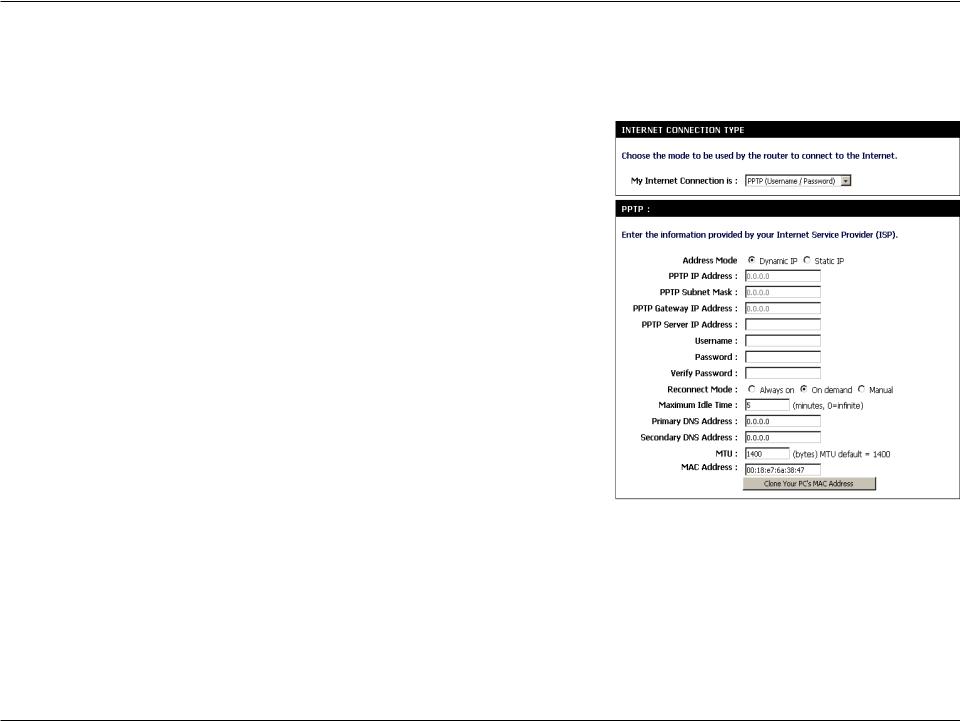
Section 3 - Configuration
PPTP
Choose PPTP (Point-to-Point-Tunneling Protocol ) if your ISP uses a PPTP connection. Your ISP will provide you with a username and password. This option is typically used for DSL services.
Address Mode: Select Static if your ISP assigned you the IP address, subnet mask, gateway, and DNS server addresses. In most cases, select Dynamic.
PPTP IP Address: Enter the IP address (Static PPTP only).
PPTP Subnet Mask: Enter the Primary and Secondary DNS Server Addresses (Static PPTP only).
PPTP Gateway: Enter the Gateway IP Address provided by your ISP.
PPTP Server IP: Enter the Server IP provided by your ISP (optional).
Username: Enter your PPTP username.
Password: Enter your PPTP password and then retype the password in the next box.
Reconnect Mode: Select either Always-on, On-Demand, or Manual.
Maximum Idle Time: Enter a maximum idle time during which the Internet connection is maintained during inactivity. To disable this feature, enable Auto-reconnect.
DNS Servers: The DNS server information will be supplied by your ISP (Internet Service Provider.)
MTU: Maximum Transmission Unit - you may need to change the MTU for optimal performance with your specific ISP. 1400 is the default MTU.
MAC Address: The default MAC Address is set to the Internet port’s physical interface MAC address on the Broadband Router. It is not recommended that you change the default MAC address unless required by your ISP. You can use the Clone Your PC’s MAC Address button to replace the Internet port’s MAC address with the MAC address of your Ethernet card.
D-Link DIR-857 User Manual |
22 |
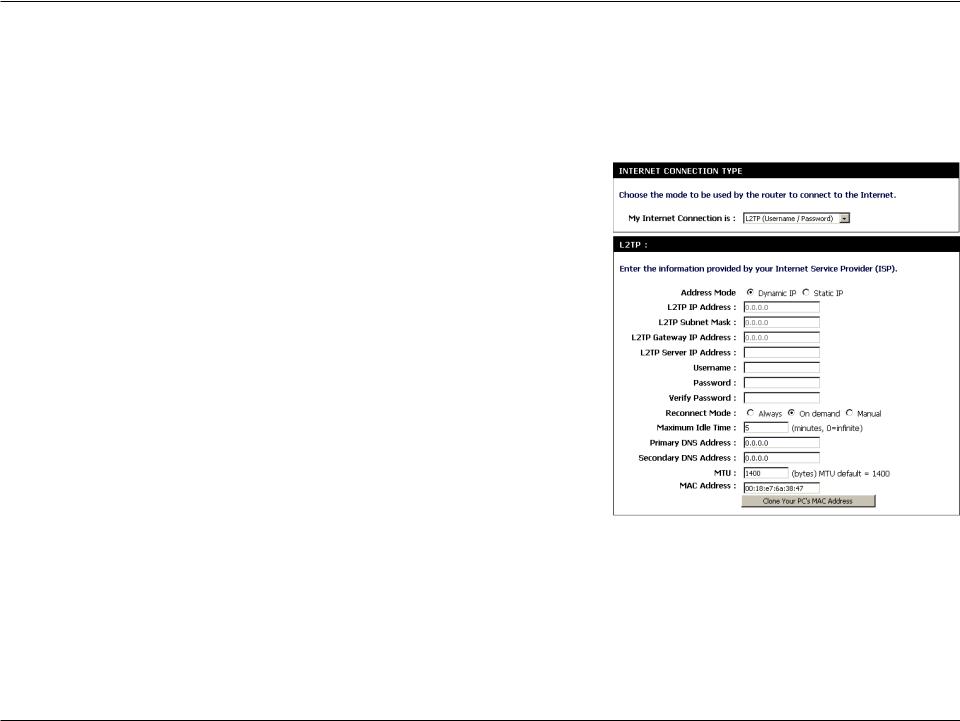
Section 3 - Configuration
L2TP
Choose L2TP (Layer 2 Tunneling Protocol) if your ISP uses a L2TP connection. Your ISP will provide you with a username and password. This option is typically used for DSL services.
Address Mode:
L2TP IP
Address:
L2TP Subnet
Mask:
L2TP Gateway:
L2TP Server IP:
Username:
Password:
Reconnect
Mode:
Maximum Idle
Time:
DNS Servers:
MTU:
Clone MAC
Address:
Select Static if your ISP assigned you the IP address, subnet mask, gateway, and DNS server addresses. In most cases, select Dynamic.
Enter the L2TP IP address supplied by your ISP (Static only).
Enter the Subnet Mask supplied by your ISP (Static only).
Enter the Gateway IP Address provided by your ISP.
Enter the Server IP provided by your ISP (optional).
Enter your L2TP username.
Enter your L2TP password and then retype the password in the next box.
Select either Always-on, On-Demand, or Manual.
Enter a maximum idle time during which the Internet connection is maintained during inactivity. To disable this feature, enable Auto-reconnect.
Enter the Primary and Secondary DNS Server Addresses (Static L2TP only).
Maximum Transmission Unit - you may need to change the MTU for optimal performance with your specific ISP. 1400 is the default MTU.
The default MAC Address is set to the Internet port’s physical interface MAC address on the Broadband Router. It is not recommended that you change the default MAC address unless required by your ISP. You can use the Clone Your PC’s MAC Address button to replace the Internet port’s MAC address with the MAC address of your Ethernet card.
D-Link DIR-857 User Manual |
23 |

Section 3 - Configuration
Static (assigned by ISP)
Select Static IP Address if all the Internet port’s IP information is provided to you by your ISP. You will need to enter in the IP address, subnet mask, gateway address, and DNS address(es) provided to you by your ISP. Each IP address entered in the fields must be in the appropriate IP form, which are four octets separated by a dot (x.x.x.x). The Router will not accept the IP address if it is not in this format.
IP Address:
Subnet Mask:
Default Gateway:
DNS Servers:
MTU:
MAC Address:
Enter the IP address assigned by your ISP.
Enter the Subnet Mask assigned by your ISP.
Enter the Gateway assigned by your ISP.
The DNS server information will be supplied by your ISP (Internet Service Provider.)
Maximum Transmission Unit - you may need to change the MTU for optimal performance with your specific ISP. 1500 is the default MTU.
The default MAC Address is set to the Internet port’s physical interface MAC address on the Broadband Router. It is not recommended that you change the default MAC address unless required by your ISP. You can use the Clone Your PC’s MAC Address button to replace the Internet port’s MAC address with the MAC address of your Ethernet card.
D-Link DIR-857 User Manual |
24 |

Section 3 - Software Configuration
DS-Lite
Another Internet Connection type is DS-Lite.
After selecting DS-Lite, the following parameters will be available for configuration:
DS-Lite Select the DS-Lite DHCPv6 Option to let the router allocate the AFTR IPv6 Configuration: address automatically. Select the Manual Configuration to enter the AFTR IPv6
address in manually.
AFTR IPv6 Address: After selecting the Manual Configuration option above, the user can enter the AFTR IPv6 address used here.
B4 IPv4 Address: Enter the B4 IPv4 address value used here.
WAN IPv6 Address: Once connected, the WAN IPv6 address will be displayed here.
IPv6 WAN Default Once connected, the IPv6 WAN Default Gateway address will be displayed
Gateway here.
D-Link DIR-857 User Manual |
25 |
